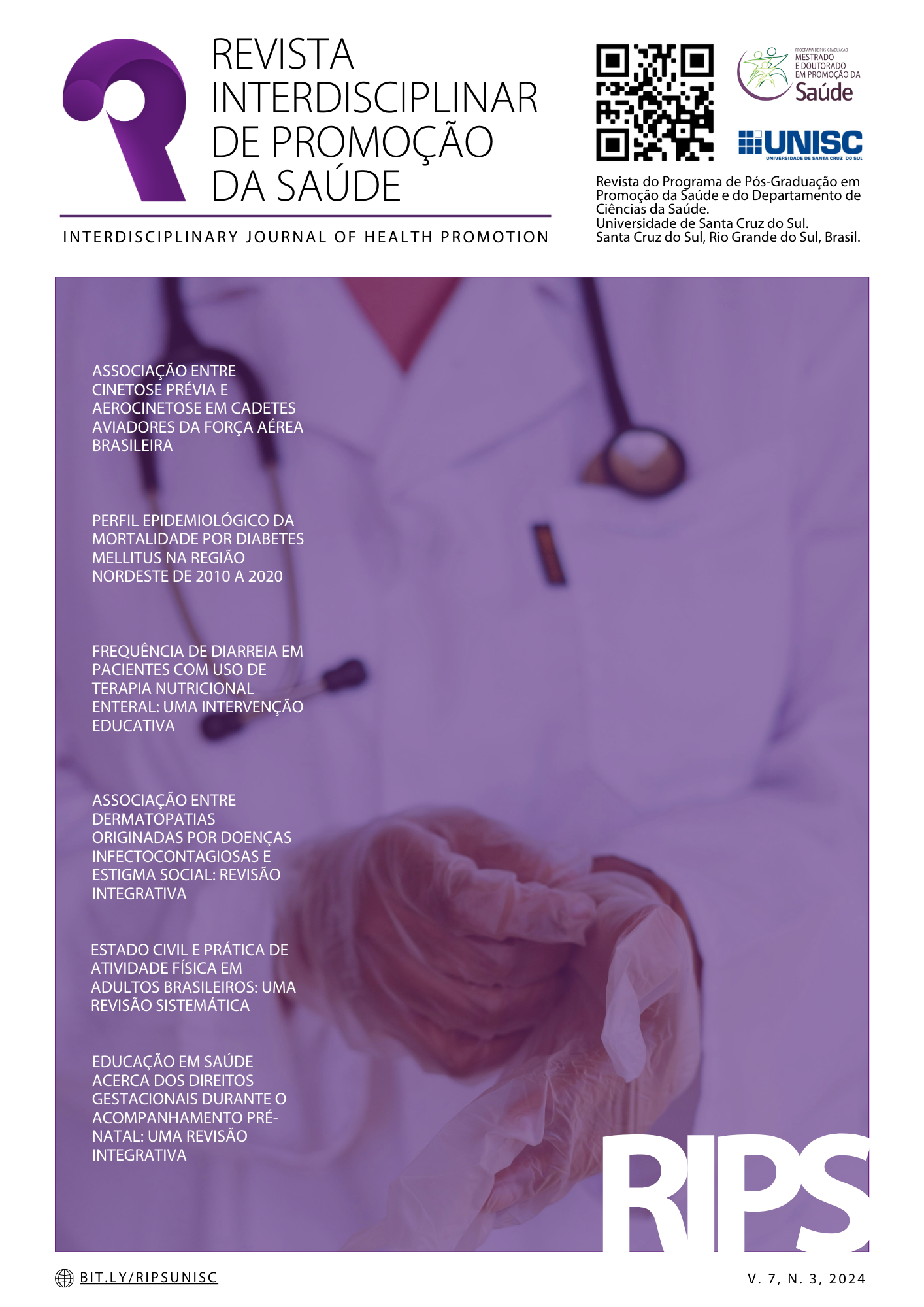ASSOCIAÇÃO ENTRE CINETOSE PRÉVIA E AEROCINETOSE EM CADETES AVIADORES DA FORÇA AÉREA BRASILEIRA
DOI:
https://doi.org/10.17058/rips.v7i3.18907Keywords:
Prevalence; pilot; aviation student; motion sickness.Abstract
Introduction: Airsickness is a disorder related to the conflict of information from orientation and balance systems that can occurs in air activity, whose symptoms vary range from drowsiness, nausea, vomiting to severe prostration. Objective: Evaluate the association of motion sickness in transport and amusement park vehicles and the occurrence of airsickness in T25-Universal and T27-Tucano aircraft in aviators of Brazilian Air Force. Method: Data were collected from 170 volunteer cadets, aged between 18 and 25 years old, through a questionnaire adapted in the Motion Sickness Susceptibility Questionnaire-Short form (MSSQ-short) containing 11 closed questions. Results: There was an association between previous motion sickness in amusement park and merry-go-round and airsickness in the T25 Universal aircraft. Individuals who had motion sickness in the amusement park are 2.5x more likely to have airsickness at T25-Universal when compared to those who did not have motion sickness, as well as individuals who had motion sickness on a merry-go-round are 1.8x more likely to have airsickness at T25-Universal when compared to those who did not have motion sickness in childhood. There was no association between experiences in parks and transport vehicles and airsickness in T27-Tucano aircraft. Conclusion: According to the purposes of the present study, only two associations were identified between previous motion sickness and aerokinetosis in the basic instruction aircraft (T25-Universal). Knowledge of previous motion sickness can contribute to airsickness understanding in aviator cadets and thus have a significant impact on learning, flight safety and pilot health.
Downloads
References
Davis JR, Johnson R, Stepanek J, Fogarty JA. Fundamentals of aerospace medicine: Fourth edition. Philadelphia: LWW, 2008.
Samuel O, Tal D. Airsickness: Etiology, Treatment, and Clinical Importance - A Review. Military Medicine 2015;180(11):1135-1139. doi: http://dx.doi.org/10.7205/MILMED-D-14-00315.
Reason JT, Brand JJ. Motion sickness. London: Academic Press; 1975.
Abadi HTB, Abadi ATB, Farahani AA, Darvishi M. Intractable airsickness associated with COVID-19: A case report. Vacunas (English Edition) 2021;22(1):52–55. doi: https://doi.org/10.1016/j.vacune.2021.01.006.
Temporal, W.F. (Org.). Medicina aeroespacial. Rio de Janeiro: Luzes, 2005.
Dorigueto RS, Kasse CA, Silva RC. Cinetose. Revista Equilíbrio Corporal e Saúde 2012;4(1):51-58.
Murdin L, Golding J, Bronstein A. Managing motion sickness. British Medical Journal (Online) 2011;343(7835):1–7. doi: https://doi.org/10.1136/bmj.d7430.
Lucertini M. Lugli V, Casagrande M, Trivelloni P. Effects of airsickness in male and female student pilots: Adaptation rates and 4-year outcomes. Aviation Space and Environmental Medicine 2008;79(7), 677–684. doi: https://doi.org/10.3357/ASEM.2146.2008.
Bezerra TAR, Neto LA, Campos FAD. A influência da aerocinetose na aprendizagem e instrução aérea de cadetes aviadores da Força Aérea Brasileira. Aviation in Focus. Journal of Aeronautical Sciences 2014;5(2): 78-84.doi: http://dx.doi.org/10.15448/2179-703X.2014.2.19596.
Brainard, A. Motion Sickness Clinical Presentation https://emedicine.medscape.com/article/2060606-clinical, out 2018
Voltolini, MMFD. Avaliação da aerocinetose em cadetes da aeronáutica brasileira. Revista da UNIFA 2013;26(33):6-14.
CNPAA, Comitê nacional de prevenção de acidentes aeronáuticos. Manual do instrutor de voo. 2016.
Golding JF. Predicting individual differences in motion sickness susceptibility by questionnaire. Personality and Individual Differences 2006;41(2):237-248. doi: https://doi.org/10.1016/j.paid.2006.01.012.
Ugur E, Konukseven BO, Topdag M, Cakmakci ME, Topdag DO. Expansion to the Motion Sickness Susceptibility Questionnaire-Short Form: A Cross-Sectional Study. Journal of Audiology & Otology 2022;26(2):76. doi: http://dx.doi.org/10.7874/jao.2021.00577.
Mittelstaedt JM. Individual predictors of the susceptibility for motion-related sickness: a systematic review. Journal of Vestibular Research 2020;30(3):165-193. doi: http://dx.doi.org/10.3233/VES-200702.
Rahimzadeh G, Tay A, Travica N, Lacy K, Mohamed S, Nahavandi D, Plawiak P, Qazani, MC, Asadi H. Nutritional and Behavioral Countermeasures as Medication Approaches to Relieve Motion Sickness: A Comprehensive Review Nutrients 2023;15(6):1320. doi: https://doi.org/10.3390/nu15061320.
Cha, Y. H., Golding, J. F., Keshavarz, B., Furman, J., Kim, J. S., Lopez-Escamez, J. A., ... & Lawson, B. D. Motion sickness diagnostic criteria: consensus document of the classification, committee of the Bárány Society, Journal of Vestibular Research 2021;31:327–344. doi: https://doi.org/10.3233/VES-200005.
Reason, J. T., & Brand, J. J. (1975). Motion sickness. New York, NY: Academic Press.
Turner A, Markey M, Le P, Reiter A, Cox C, Simmons S, Rao MB, Altman L, Davis K, Huber D, Dufour JS, Marras W, Bhattacharya A. Disorientation effects, circulating small ribonucleic acid, and genetic susceptibility on static postural stability. Heliyon 2023;9(3):1-12. doi: https://doi.org/10.1016/j.heliyon.2023.e14413.
Lucertini M, Verde P, Trivelloni P. Rehabilitation from airsickness in military pilots: Long-term treatment effectiveness. Aviation Space and Environmental Medicine 2013;84(11):1196–1200. doi: https://doi.org/10.3357/ASEM.3509.2013.
Bronstein AM, Golding JF, Gresty MA. Vertigo and dizziness from environmental motion: visual vertigo, motion sickness, and drivers' disorientation. Semin Neurol 2013;33(3):219-230. doi: https://doi.org/10.1055/s-0033-1354602.
Li C, Xu J, Yin D, Zhang Y, Shan D, Jiang X, Shang L. Prevalence and trigger factors of functional gastrointestinal disorders among male civil pilots in China. Scientific Reports 2021;11(1): 1-13. doi: https://doi.org/10.1038/s41598-021-81825-0.
Downloads
Published
How to Cite
Issue
Section
License
A submissão de originais para este periódico implica na transferência, pelos autores, dos direitos de publicação impressa e digital. Os direitos autorais para os artigos publicados são do autor, com direitos do periódico sobre a primeira publicação. Os autores somente poderão utilizar os mesmos resultados em outras publicações indicando claramente este periódico como o meio da publicação original. Em virtude de sermos um periódico de acesso aberto, permite-se o uso gratuito dos artigos em aplicações educacionais e científicas desde que citada a fonte conforme a licença CC-BY da Creative Commons.




